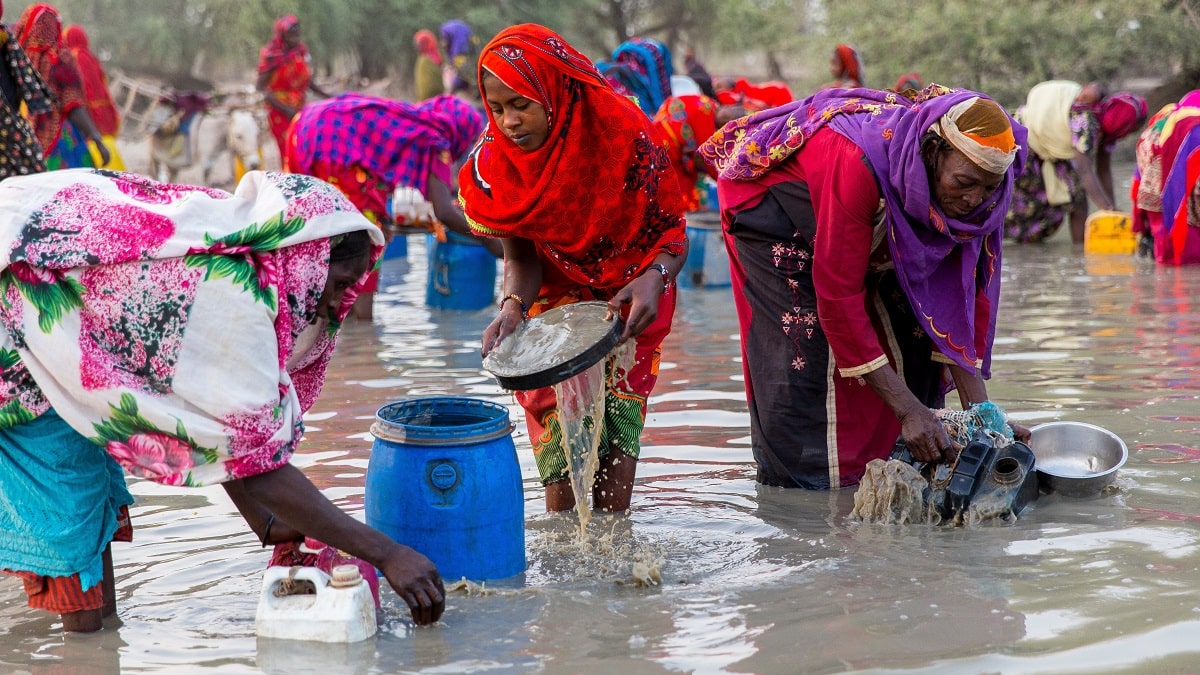

Finance
What Does GDP Per Capita Mean?
Published: October 29, 2023
Learn the meaning of GDP per capita and its importance in the field of finance. Understand how this economic metric affects individuals and countries alike.
(Many of the links in this article redirect to a specific reviewed product. Your purchase of these products through affiliate links helps to generate commission for LiveWell, at no extra cost. Learn more)
Table of Contents
Introduction
Welcome to the world of finance, where numbers and economic indicators play a crucial role in understanding the dynamics of economies. One such important measure is GDP per capita, a metric that provides insight into the average economic well-being of individuals in a country. GDP per capita, also known as income per capita, is a key indicator used to assess the living standards and economic development of a nation.
GDP, or Gross Domestic Product, refers to the total value of goods and services produced within a country’s borders during a specific period. It serves as a measure of economic activity and growth. GDP per capita, on the other hand, divides the total GDP by the population of a country, giving us an average income per person. It is a significant metric used to compare the economic performance of different countries and evaluate the standard of living.
In this article, we will delve deeper into the concept of GDP per capita, exploring its calculation, importance, limitations, factors affecting it, and its various uses. By understanding GDP per capita, you will gain valuable insights into how economies function and how individual incomes contribute to overall national prosperity.
Definition of GDP per capita
GDP per capita is a measure that expresses the average income or output per person in a country. It is calculated by dividing the total GDP of a country by its population. Essentially, it provides an estimate of the economic well-being of individuals within a nation.
GDP per capita is often considered a reliable indicator of the standard of living in a country. It reflects the average economic resources available to individuals, including wages, salaries, profits, and government transfers, among other factors. By analyzing GDP per capita, policymakers, economists, and investors can gain valuable insights into the economic development and living conditions of a nation.
It is important to note that GDP per capita is usually measured in a specific time period, such as annually or quarterly. This allows for comparisons between different countries and enables the tracking of changes in living standards over time.
For example, if a country has a GDP of $1 trillion and a population of 100 million, the GDP per capita would be $10,000. This means that, on average, each individual in the country has an income of $10,000 per year.
GDP per capita can be measured in nominal terms, which uses current market prices, or in real terms, which adjusts for inflation. Real GDP per capita provides a more accurate measure of changes in living standards over time, as it takes into account the effects of inflation on purchasing power.
Overall, GDP per capita serves as an important indicator of the economic well-being and standard of living within a country, enabling comparisons between nations and aiding in the analysis of economic performance and development.
Calculation of GDP per capita
The calculation of GDP per capita involves simple mathematical steps to determine the average income per person in a country. It is derived by dividing the total GDP of a nation by its population size.
Here is the formula for calculating GDP per capita:
GDP per capita = Total GDP ÷ Population
To begin the calculation, the first step is to determine the total GDP of the country. GDP is typically calculated using either the production approach, income approach, or expenditure approach. Each approach involves measuring the value of all goods and services produced in the country during a specific period.
Once the GDP is determined, the next step is to gather accurate population data. The population can be obtained through national census data or estimated by government agencies and statistical organizations.
After obtaining the GDP and population figures, simply divide the total GDP by the population to arrive at the GDP per capita value.
For example, consider a country with a total GDP of $1 trillion and a population of 100 million:
GDP per capita = $1,000,000,000,000 ÷ 100,000,000 = $10,000
This means that, on average, each person in the country has an income of $10,000.
It is important to note that GDP per capita can be calculated on various scales, such as annual, quarterly, or even daily. The calculation can also be adjusted for inflation to obtain real GDP per capita, which provides a more accurate measure of changes in income and living standards over time.
Overall, calculating GDP per capita is a relatively straightforward process that involves dividing the total GDP of a country by its population, allowing for a meaningful assessment of the average income per person in a nation.
Importance of GDP per capita
GDP per capita is a significant measure in economics as it plays a crucial role in evaluating the standard of living and economic well-being of individuals within a country. It provides valuable insights into the overall economic development and progress of a nation. Here are some key reasons why GDP per capita is important:
1. Economic Comparison: GDP per capita allows for meaningful comparisons between different countries. By examining the GDP per capita of various nations, economists, policymakers, and investors can gauge the relative economic prosperity and living standards of each country and make informed decisions regarding trade, investment, and development strategies.
2. Economic Growth: Tracking changes in GDP per capita over time is crucial for assessing the economic progress and growth of a country. Higher GDP per capita indicates an increase in average income, which suggests improved living standards and greater economic opportunities. Governments can use this information to measure the effectiveness of their policies and identify areas that require attention for economic development.
3. Poverty and Inequality: GDP per capita serves as an important tool in assessing poverty levels and income inequality within a country. Lower GDP per capita may indicate a higher percentage of the population living in poverty or facing economic hardships. Monitoring changes in GDP per capita can help policymakers identify regions or groups that require targeted interventions to reduce poverty and promote income equality.
4. Human Development: GDP per capita is closely associated with human development. Countries with higher GDP per capita tend to have better access to education, healthcare, and infrastructure, which can contribute to higher life expectancies, improved literacy rates, and overall well-being. By focusing on increasing GDP per capita, governments can prioritize investments in human capital and social development.
5. Policy Planning: GDP per capita serves as a benchmark for economic policy planning and formulation. Governments can use this metric to determine the allocation of resources, prioritize economic sectors for development, and implement policies that promote job creation and income growth. It provides a basis for economic planning and assists in the evaluation of the impact of various policies on the welfare of the population.
Overall, GDP per capita is a crucial indicator that highlights the economic well-being and standard of living within a country. It aids in economic comparisons, tracking growth, addressing poverty and inequality, promoting human development, and guiding policy decisions. By understanding and analyzing GDP per capita, stakeholders can work towards achieving sustainable economic growth and improving the overall welfare of their population.
Limitations of GDP per capita
While GDP per capita is a widely used measure to assess the economic well-being of individuals in a country, it is important to acknowledge its limitations. GDP per capita has several shortcomings that can impact its accuracy and fail to provide a comprehensive representation of the living standards and welfare of a population. Here are some key limitations:
1. Inequality: GDP per capita does not account for income inequality within a country. It provides an average income per person but fails to reflect the distribution of wealth. A high GDP per capita may mask significant disparities and pockets of poverty within a nation.
2. Non-Monetary Transactions: GDP per capita primarily focuses on monetary transactions and often overlooks non-market activities, such as household production, volunteer work, and the informal sector. These activities can have a significant impact on the overall well-being of individuals but are not adequately captured in GDP per capita calculations.
3. Quality of Life Indicators: GDP per capita solely focuses on economic output and does not take into account other vital indicators of quality of life, such as access to healthcare, education, and environmental sustainability. A country with a high GDP per capita may still have inadequate social services and environmental issues.
4. Externalities: GDP per capita does not account for externalities, such as pollution, depletion of natural resources, and social costs. Economic activities that contribute to GDP per capita may have negative impacts on the environment and society, which are not reflected in the measure.
5. Informal Economy: GDP per capita often fails to capture the contributions of the informal economy, which includes activities such as street vending and informal labor. These activities can significantly contribute to the economic livelihoods of individuals but are not accurately reflected in the formal GDP measurements.
6. Non-Monetized Sectors: Certain sectors of the economy, such as caregiving and household work, do not have a monetary value attached to them. These sectors, predominantly performed by women, are essential for the functioning of society but are often excluded from GDP calculations, distorting the representation of economic well-being.
7. Quality vs. Quantity: GDP per capita measures quantity of economic output, but it does not consider the quality of goods and services produced. A country with a high GDP per capita may still lack access to high-quality education, healthcare, and infrastructure.
It is important to use GDP per capita as a starting point for economic analysis, but it should be complemented with other indicators that capture a more comprehensive view of societal well-being. Understanding the limitations of GDP per capita can help policymakers and researchers develop more robust metrics that consider a broader range of factors to assess the living standards and welfare of a population.
Factors Affecting GDP per capita
GDP per capita is influenced by various factors that shape the economic well-being and standard of living within a country. Understanding these factors can provide valuable insights into the drivers of economic growth and development. Here are some key factors that affect GDP per capita:
1. Economic Policies: Government policies, such as fiscal policy, monetary policy, and trade policies, impact GDP per capita. Sound economic policies that promote investment, innovation, and entrepreneurship can stimulate economic growth and improve the standard of living. On the other hand, poor or misaligned policies can hinder economic development and limit GDP per capita growth.
2. Human Capital: The knowledge, skills, and education of the workforce play a significant role in determining GDP per capita. A highly educated and skilled workforce is more productive and capable of driving economic growth. Investments in education, vocational training, and lifelong learning can enhance human capital and contribute to higher GDP per capita.
3. Physical Infrastructure: Quality infrastructure, including transportation networks, energy systems, telecommunications, and water and sanitation facilities, is crucial for economic development. Adequate infrastructure promotes productivity, facilitates trade and investment, and attracts businesses, thereby positively influencing GDP per capita.
4. Technological Advancements: Technological progress and innovation are important drivers of economic growth and higher GDP per capita. Investments in research and development, as well as the adoption and diffusion of new technologies, can improve productivity, create new industries, and enhance competitiveness, leading to higher incomes and a better standard of living.
5. Natural Resources: The availability and exploitation of natural resources can impact GDP per capita. Countries endowed with abundant natural resources, such as oil, minerals, or agricultural land, may experience higher GDP per capita if these resources are effectively managed and their benefits are equitably distributed. However, overdependence on natural resources can also lead to economic volatility and hinder diversification.
6. Political Stability: Political stability and good governance are fundamental for economic growth and welfare. Countries with stable political environments, strong institutions, and low levels of corruption tend to attract more investment, foster business confidence, and encourage entrepreneurship, ultimately leading to higher GDP per capita.
7. Global Factors: International trade relationships, globalization, and geopolitical dynamics can also influence GDP per capita. Access to global markets, favorable trade agreements, and integration into the global economy can boost exports, attract foreign direct investment, and drive economic growth.
It is important to note that the influence of these factors on GDP per capita can vary across countries and contexts. Different countries may experience different drivers of economic growth and face distinct challenges. Understanding the unique factors at play in a particular country can help policymakers identify areas for intervention and develop strategies to promote sustained economic development and improve GDP per capita.
Uses of GDP per capita
GDP per capita is a widely used measure that provides valuable insights into the economic well-being and standard of living of individuals within a country. It serves various purposes and is utilized by policymakers, economists, and researchers to inform decision-making and evaluate economic performance. Here are some key uses of GDP per capita:
1. Economic Comparisons: GDP per capita enables meaningful comparisons between countries. It allows economists and policymakers to assess the relative economic development and living standards of different nations. By analyzing the GDP per capita of various countries, governments can identify best practices, learn from successful economies, and make informed decisions regarding trade, investment, and development strategies.
2. Poverty Measurement: GDP per capita is used as a key indicator to measure and monitor poverty levels within a country. It helps identify regions or segments of the population with low income and can guide policymakers in designing targeted poverty reduction programs. By tracking changes in GDP per capita, governments can assess the effectiveness of poverty alleviation initiatives over time.
3. Economic Growth Assessment: GDP per capita is an important tool for monitoring and evaluating economic growth. By tracking changes in GDP per capita over time, policymakers and economists can assess the overall progress and development of a country. It helps identify periods of economic expansion or recession and informs policy decisions to stimulate sustainable growth and improve living standards.
4. Policy Formulation: GDP per capita serves as a basis for economic policy formulation. Governments can use this metric to allocate resources, prioritize sectors for development, and design policies that promote job creation and income growth. It provides policymakers with insights into the economic conditions and well-being of the population, enabling them to make informed decisions to improve the overall welfare of the society.
5. International Aid and Investment: External actors, such as international organizations and investors, often consider GDP per capita when determining aid allocation or investment opportunities. It helps determine the level of support needed by countries and provides an indication of the economic potential and market size. Higher GDP per capita can attract foreign investments and stimulate economic partnerships, contributing to further growth and development.
6. Social Development Planning: GDP per capita plays a crucial role in social development planning and resource allocation. It helps identify regions or segments of the population that require targeted investments in areas such as education, healthcare, and infrastructure. By using GDP per capita as a guide, governments can make informed decisions to address social disparities and enhance overall quality of life.
7. International Rating and Ranking: GDP per capita is often used by rating agencies and international organizations to assess the creditworthiness and competitiveness of countries. It influences the sovereign rating and can impact the cost of borrowing for governments. Higher GDP per capita is associated with higher rankings and positions on global indices, indicating a stable and prosperous economy.
In summary, GDP per capita is a versatile measure that finds numerous applications in economic analysis and policy-making. It helps compare economies, measure poverty, assess economic growth, formulate policies, attract international aid and investment, guide social development planning, and determine international rankings. However, its use should be complemented with other indicators to provide a more comprehensive understanding of the overall well-being and quality of life within a country.
Conclusion
GDP per capita is a fundamental indicator that provides valuable insights into the economic well-being and standard of living within a country. It serves as a measure of average income per individual and plays a crucial role in assessing economic development, poverty levels, and social welfare. Despite its limitations, GDP per capita is widely used by policymakers, economists, and researchers to inform decision-making and evaluate the performance of economies.
Throughout this article, we have explored the definition and calculation of GDP per capita, highlighting its importance in economic comparisons, growth assessment, poverty measurement, and policy formulation. We have also discussed the factors that can affect GDP per capita, emphasizing the role of economic policies, human capital, infrastructure, technology, natural resources, political stability, and global factors.
Moreover, we have recognized the limitations of GDP per capita, including its inability to account for income inequality, non-market activities, quality of life indicators, externalities, the informal economy, and non-monetized sectors. It is crucial to consider these limitations and complement GDP per capita with other indicators to gain a more comprehensive understanding of the economic well-being and welfare of a population.
Lastly, we have explored the various uses of GDP per capita, such as economic comparisons, poverty measurement, economic growth assessment, policy formulation, international aid and investment, social development planning, and international rating and ranking. These uses highlight the versatility and significance of GDP per capita in informing decision-making processes and promoting sustainable economic development.
GDP per capita is a valuable tool that provides a snapshot of the economic conditions and living standards within a country. While it is an important measure, it should not be viewed as the sole indicator of development and welfare. The utilization of a broader range of indicators, including social, environmental, and governance metrics, is essential for a comprehensive assessment of an economy and for designing effective policies that promote the well-being of individuals and societies.
By understanding GDP per capita and its applications, stakeholders can work towards creating inclusive and sustainable economic systems that prioritize the improvement of living standards, reduction of poverty, and overall societal well-being.














